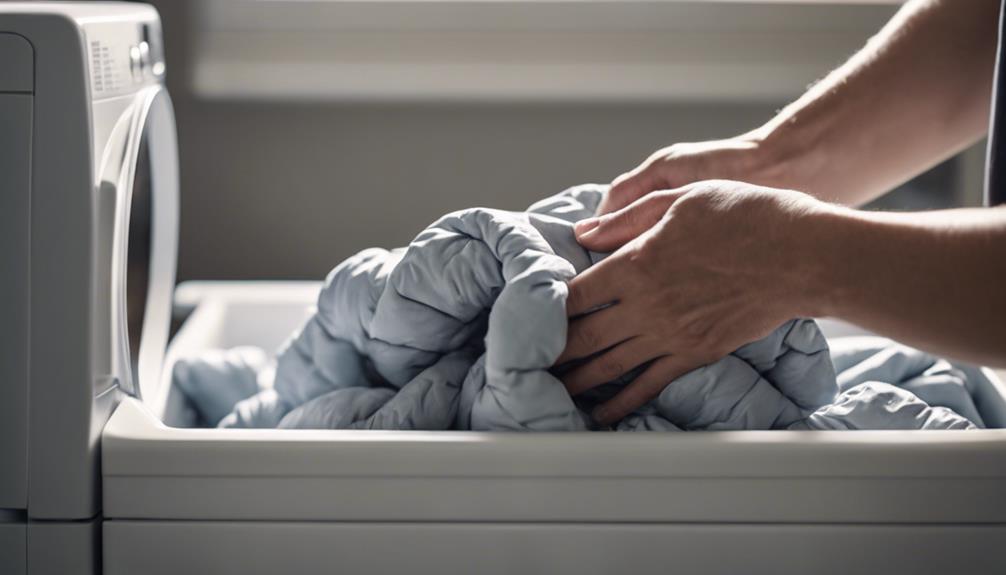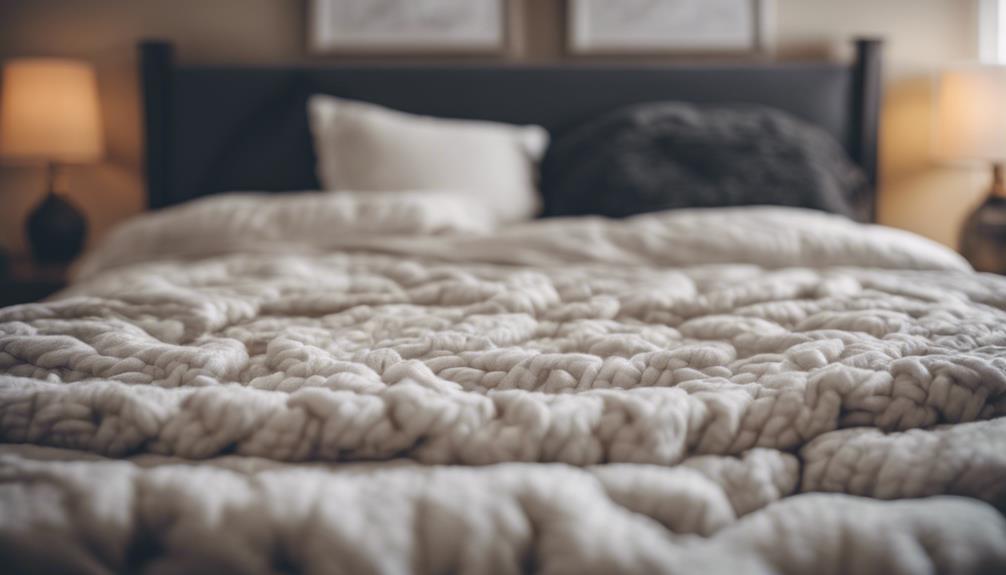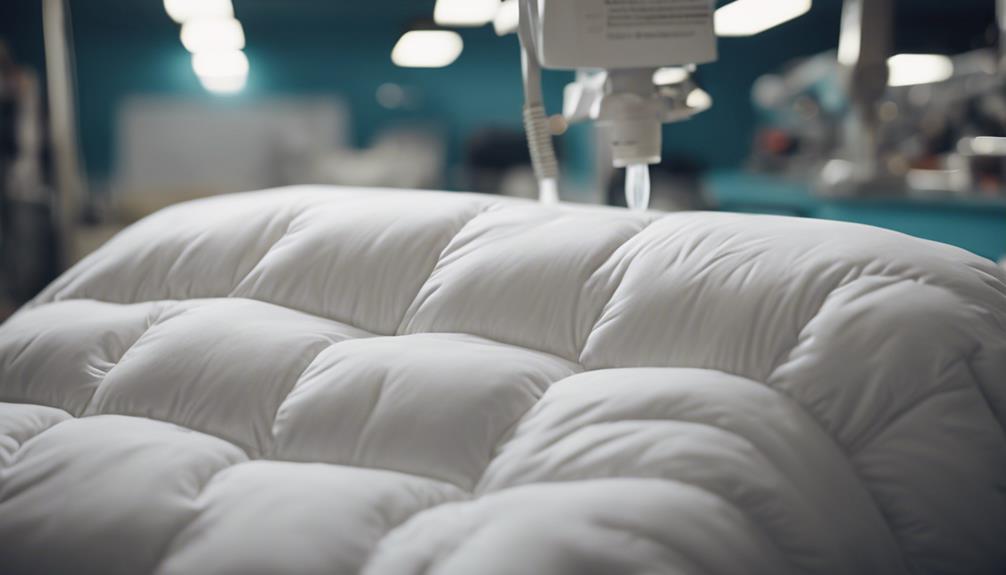If your comforter feels stiff after drying, issues like hard water minerals, over-drying, and residue could be to blame. Uneven distribution of detergent or overloading the dryer could also cause this problem. Using fabric softener, dryer balls, or tennis balls can help fluff up the fibers. High heat settings might make the fibers stiff, whereas low to medium settings can help maintain softness. It’s important to understand the fabric composition, follow care instructions, and recognize natural materials like cotton or wool. To avoid stiffness, consider air drying, using fabric softener, and shaking out the comforter before drying. Following these additional tips can help preserve the softness of your comforter.
Key Takeaways
- Avoid high heat settings to prevent stiffness and damage.
- Use fabric softener in the wash and rinse cycles.
- Shake out comforter before drying to prevent clumping.
- Consider air drying or low heat settings for softness.
- Regularly use fabric softener to maintain softness.
Drying Process and Comforter Texture
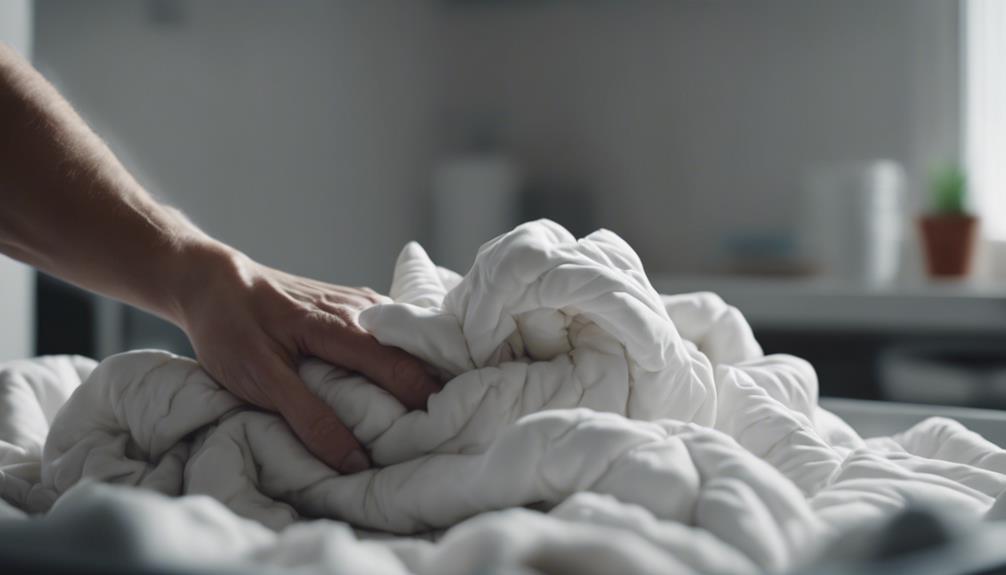
When we dry our comforters, the textures can become crunchy due to various factors such as uneven detergent distribution or overloading the dryer. It's crucial to guarantee that the detergent and fabric softener are evenly distributed during the washing process to prevent stiffness in the comforter after drying.
Overloading the dryer with too many items, including the comforter, can hinder proper air circulation, leading to a crunchy texture. To maintain the softness of the comforter, it's advisable to follow the manufacturer's recommendations on load size for your specific dryer.
Additionally, using fabric softener or dryer sheets can help reduce the crunchiness of the comforter by adding a layer of softness to the fibers. When drying the comforter, consider using dryer balls or clean tennis balls to help fluff up the fibers and prevent a stiff texture. These items can aid in maintaining the comforter's softness and preventing it from becoming crunchy during the drying process.
Impact of High Heat Settings
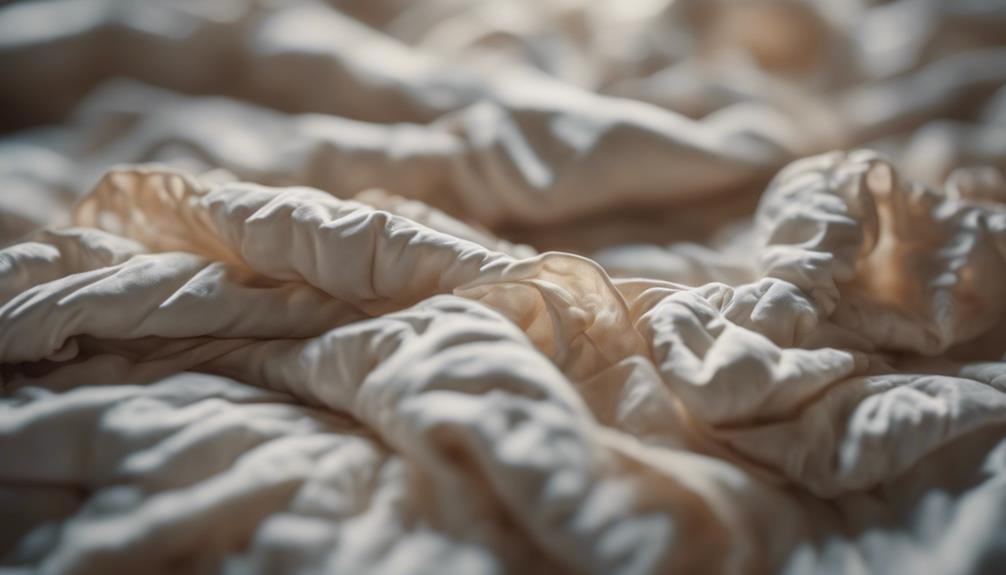
When it comes to drying your comforter, high heat settings can be detrimental. These settings have a direct impact on the fabric and fibers of the comforter.
Excessive heat can cause stiffness and damage, leading to that unwanted crunchy texture.
Heat Affects Fabric
Using high heat settings in the dryer can greatly impact the fabric of your comforter, causing it to become stiff and crunchy. Excessive heat during the drying process can alter the structure of the fabric, making it less flexible and more rigid. This change in texture is especially noticeable with delicate or synthetic materials commonly found in comforters.
To maintain the softness and comfort of your bedding, opt for low or medium heat settings when drying your comforter. Following the care instructions provided on the label can also help prevent the fabric from becoming crunchy. By being mindful of the heat levels during drying, you can preserve the quality and feel of your comforter for a longer period.
Heat Damages Fibers
High heat settings in the dryer can greatly damage the fibers of a comforter, leading to a crunchy texture. Excessive heat during the drying process can make the fibers stiff and brittle, resulting in an unpleasant crunchiness. To illustrate the impact of high heat settings, consider the following table:
| High Heat Settings Effects on Comforter Fibers |
|---|
| Fibers become stiff and brittle |
| Loss of natural softness and flexibility |
| Significant impact on delicate fabrics |
| Crunchy texture after washing and drying |
| Be mindful of high heat for a softer comforter |
When washing your comforter, be cautious to use a gentle or low-heat setting to prevent damage to the fibers and maintain its softness.
Natural Materials in Comforters
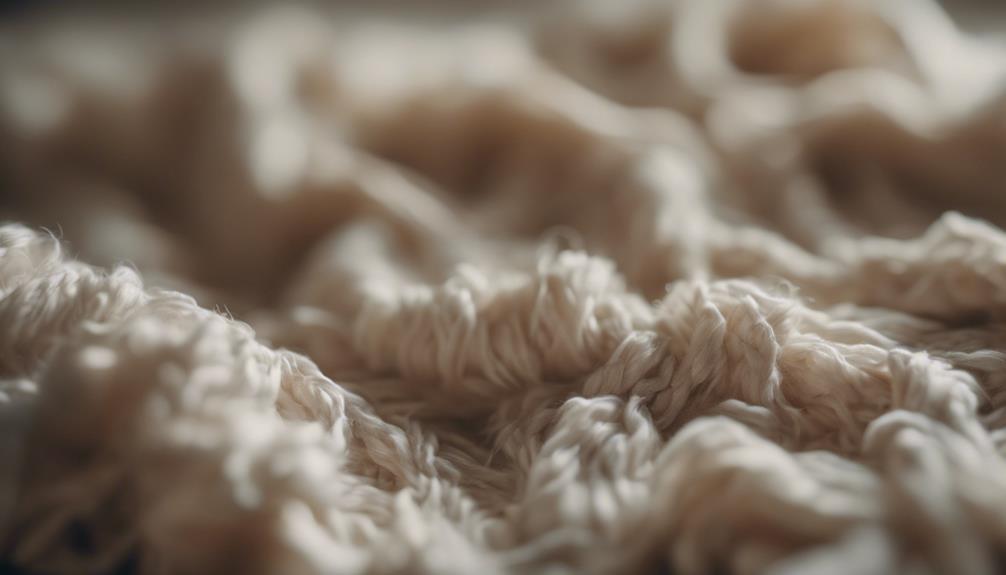
Natural materials such as cotton, wool, and silk are commonly used in comforters and may lead to a crunchy texture after drying due to their inherent properties. Cotton comforters, for example, can feel crunchy because the fibers stiffen when exposed to heat and moisture during the drying process.
Similarly, wool comforters may develop a crunchy feel if not properly dried, as wool fibers have a tendency to clump together and harden when wet. On the other hand, silk comforters might also exhibit a crunchy texture post-drying if handled roughly, as silk fibers are delicate and prone to damage.
To maintain the softness of comforters made from these natural materials, it's essential to follow proper care guidelines, including gentle washing techniques and appropriate drying methods. By understanding the characteristics of cotton, wool, and silk, one can better prevent the crunchiness that may arise from drying these natural material comforters.
Effects of Over-Drying
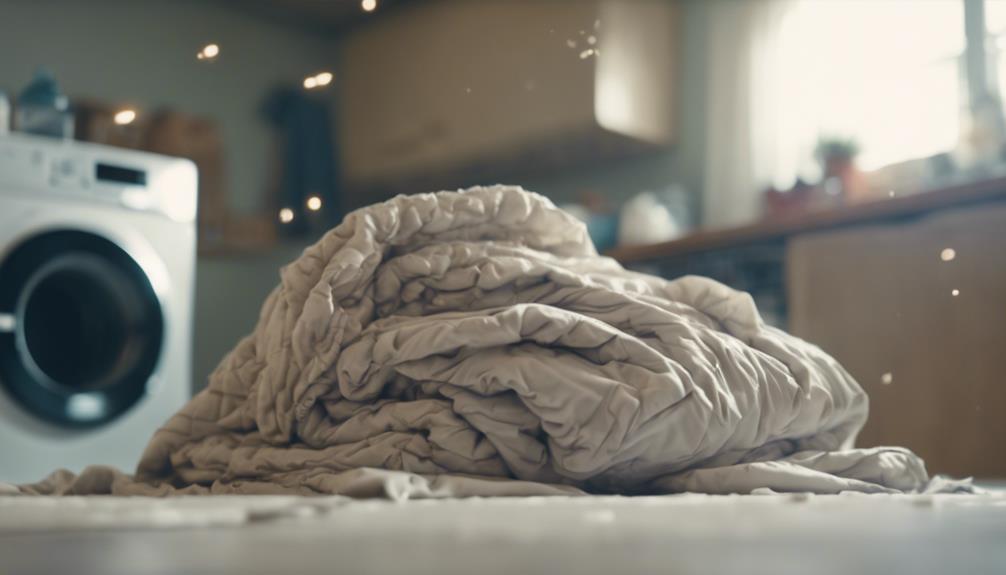
Over-drying a comforter can lead to the loss of its natural oils and result in a stiff, crunchy texture. When exposed to excessive heat in the dryer, the comforter's fibers can suffer damage, causing it to feel rough and unpleasant. The filling inside the comforter is also at risk of clumping together under prolonged high heat conditions, contributing to that undesirable crunchy sensation. Not only does over-drying strip the comforter of its softness and fluffiness, but it can also make it uncomfortable to sleep under.
To prevent the crunchiness that arises from over-drying, it's essential to adhere to proper care instructions and utilize low heat settings when drying your comforter. By following these guidelines, you can maintain the natural oils in the fabric, preserve the integrity of the fibers, and make sure that your comforter retains its soft and cozy feel. Remember, a little care in the drying process can go a long way in keeping your comforter plush and inviting.
Maintaining Comforter Softness
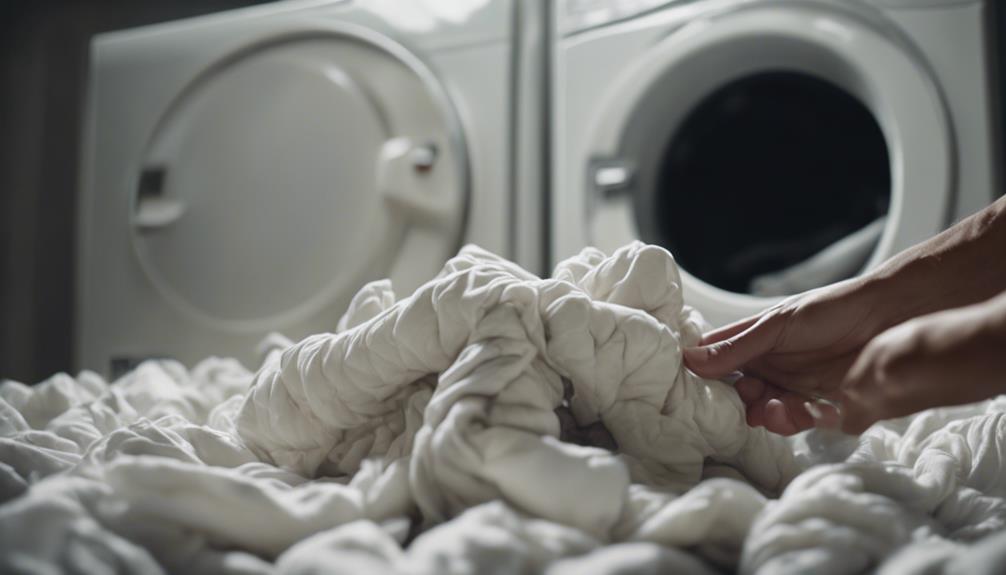
To maintain comforter softness, we can explore various methods such as softening fabric naturally, using fabric softener, and employing proper drying techniques.
These practices can help keep the comforter feeling plush and cozy, enhancing our overall sleeping experience.
Softening Fabric Naturally
How can we naturally soften our comforter to maintain its softness and prevent crunchiness?
One way is to add white vinegar during the rinse cycle, which helps soften the fabric naturally.
Another effective method is using wool dryer balls in the dryer. These balls can fluff up the comforter and soften the fabric without harsh chemicals.
Additionally, air drying the comforter outdoors can also help maintain its softness and prevent it from becoming crunchy.
Using Fabric Softener
Using fabric softener in your laundry routine can help maintain the softness of your comforter after drying, reducing stiffness and crunchiness. Liquid fabric softeners added during the rinse cycle or dryer sheets in the dryer can provide a soft touch to your comforter. These products work by coating the fabric fibers, making them feel smoother and diminishing static electricity.
However, be cautious not to overuse fabric softener as it may leave residue on the comforter, potentially decreasing its absorbency over time. For a more natural approach, consider adding white vinegar to the rinse cycle, which can also aid in softening the comforter without leaving any unwanted residue. Experiment with different amounts to find the right balance for maintaining the softness of your comforter.
Proper Drying Techniques
Shaking out the comforter intermittently during the drying cycle can help prevent clumping and maintain its softness. To guarantee your comforter stays soft, follow these proper drying techniques:
- Use Low Heat Settings: Opt for low heat settings in the dryer to prevent the comforter from becoming crunchy.
- Add Dryer Balls: Consider adding dryer balls or clean tennis balls to the dryer to help fluff and soften the comforter during drying.
- Avoid Over-Drying: Be cautious not to over-dry the comforter, as this can lead to stiffness and crunchiness.
Air Drying Vs. Machine Drying

Opting for air drying over machine drying can greatly impact the texture and quality of your comforter. Air drying allows the comforter to maintain its softness and prevent it from becoming crunchy, while machine drying, especially on high heat settings, can lead to loss of fluffiness and a crunchy texture. The speed of drying is a key factor in how the comforter feels after washing. Air drying provides a slower and more even drying process, which helps preserve the comforter's quality and texture. On the other hand, machine drying exposes the comforter to rapid heat, which can result in clumping and hardening, leading to a less desirable texture.
| Air Drying | Machine Drying |
|---|---|
| Maintains softness | May cause loss of fluffiness |
| Prevents crunchiness | Can lead to a crunchy texture |
| Slower, more even drying | Rapid heat exposure can cause clumping |
Preventing Crunchiness Tips
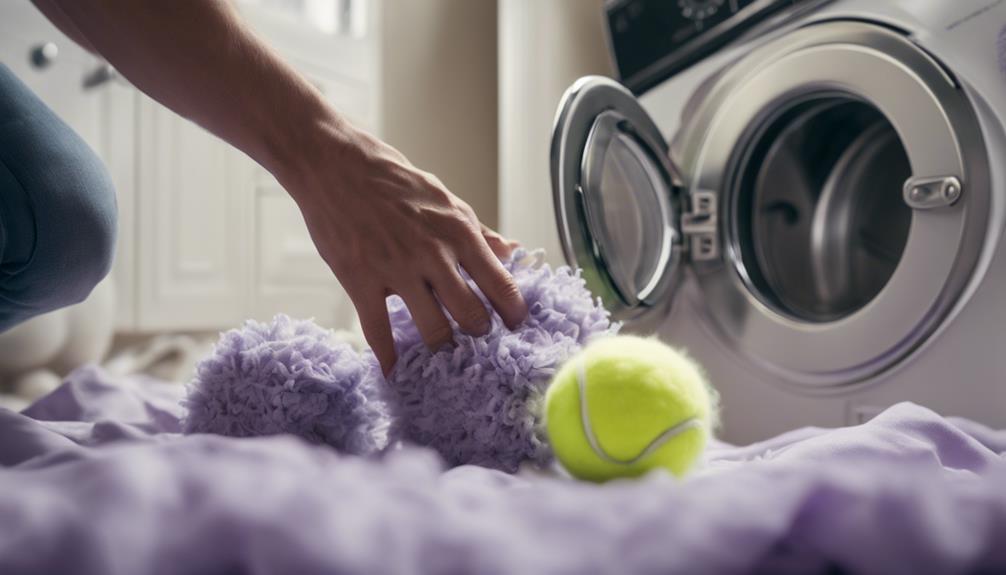
To prevent your comforter from becoming crunchy after drying, consider using fabric softener in the wash cycle. Drying it on a low heat setting and giving it a good shake before placing it in the dryer are also recommended steps. These simple tips can help maintain the softness and fluffiness of your comforter, ensuring a cozy and comfortable night's sleep without any unwanted crunchiness.
Remember to follow these suggestions to keep your bedding feeling fresh and inviting.
Use Fabric Softener
We find that adding fabric softener during the rinse cycle can effectively prevent crunchiness in comforters by softening the fibers and reducing static electricity.
Here are some key points to keep in mind when using fabric softener for your comforter:
- Choose a fabric softener specifically designed for bedding to guarantee maximum softness and care for your comforter.
- Add the fabric softener to the designated compartment in your washing machine to evenly distribute it during the rinse cycle.
- Regularly using fabric softener in your laundry routine can help maintain the softness of your comforter and prevent it from becoming crunchy after drying.
Dry on Low
Adding fabric softener during the rinse cycle can prevent crunchiness in comforters, and drying on a low heat setting further enhances the softness and fluffiness of the fibers.
When drying your comforter, opt for a low heat setting to avoid excessive heat exposure that can lead to stiffness and crunchiness. Gentle drying at a low temperature helps preserve the quality of the comforter, ensuring it remains cozy and comfortable.
High heat can be detrimental to the fibers, impacting the overall feel of the comforter. By choosing a lower temperature setting in the dryer and following the care instructions, you can maintain the softness and prevent crunchiness after drying.
Shake Before Use
Shaking your comforter before use helps fluff it up and prevent crunchiness caused by clumping during drying. Here are some tips to make sure your comforter stays soft and cozy:
- Redistribute Filling: Properly shaking out your comforter can help redistribute the filling, maintaining its softness.
- Prevent Fiber Clumping: By shaking your comforter, you can prevent the fibers from sticking together and creating a crunchy texture.
- Improve Airflow: Regularly shaking your comforter can enhance airflow and prevent moisture buildup that leads to crunchiness.
Remember to shake your comforter thoroughly after drying to maintain its loftiness and prevent it from feeling crunchy. This simple step can make a big difference in the comfort and quality of your bedding.
Choosing the Right Drying Method
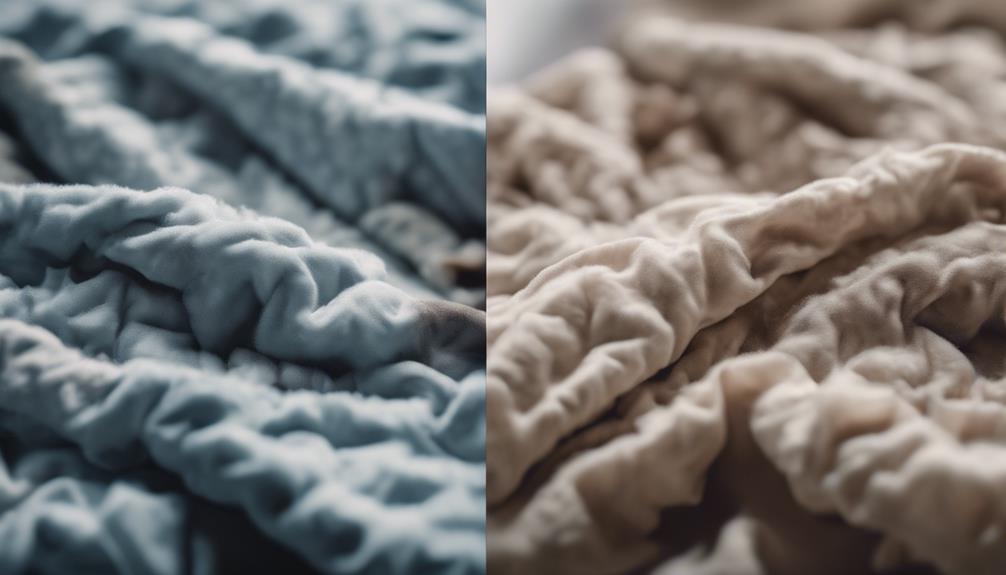
Opting for the proper drying method for your comforter is crucial in preventing it from becoming crunchy after drying. When using the dryer, consider using a low heat setting or adding dryer balls to reduce the crunchiness of your comforter.
Overloading the dryer should be avoided to allow proper airflow, which helps prevent crunchiness. Before drying, make sure to shake out your comforter to prevent clumps and guarantee even drying.
Additionally, adding a tennis ball or two in the dryer can help fluff up your comforter and maintain its softness. If possible, air drying your comforter can also be beneficial in preventing crunchiness.
Factors Affecting Comforter Texture
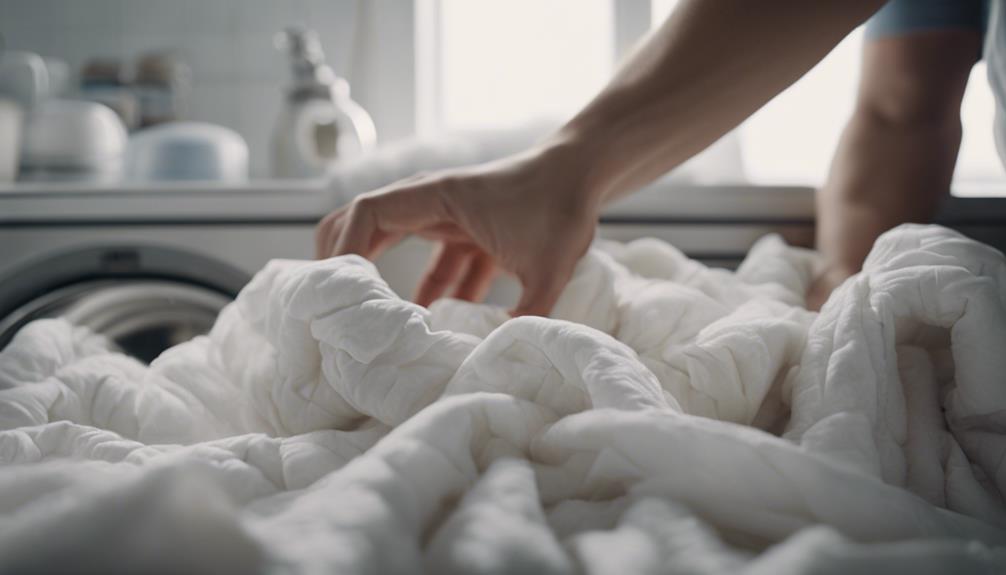
Hard water with high mineral content can greatly impact the softness of a comforter's fabric, leading to a crunchy feel after drying. This is one of the key factors affecting the texture of your comforter.
Here are some other factors that can contribute to a crunchy texture:
- Over-drying: Excessive heat and lack of moisture retention from over-drying can cause the comforter to become stiff and crunchy.
- Residue from Detergent and Fabric Softener: Using too much detergent or fabric softener can leave residue on the comforter, leading to a crunchy texture.
- Fabric Composition: Comforters with a high percentage of synthetic fibers are more prone to becoming crunchy after drying compared to those made with natural fibers.
Conclusion and Final Tips
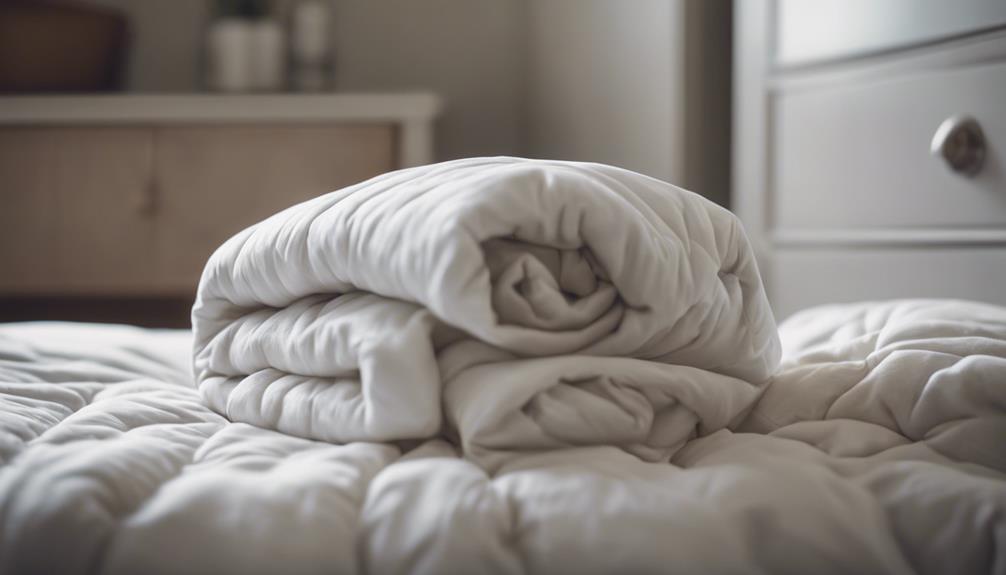
To maintain the softness of your comforter and prevent it from becoming crunchy, consider implementing these final tips. Check the care label for specific drying instructions to avoid damage.
Overloading the dryer may cause clumping and crunchiness, so guarantee proper spacing. Adding dryer balls or clean tennis balls during the drying process can help fluff up the comforter and prevent crunchiness.
For a longer-lasting softness, contemplate air drying your comforter partially or fully. Avoid using high heat settings in the dryer, as they can damage the fibers and lead to crunchiness.
Frequently Asked Questions
How to Soften a Crunchy Comforter?
To soften a crunchy comforter, try adding tennis balls or dryer balls in the dryer to fluff it up and prevent clumping. Use fabric softener or a dryer sheet for added softness.
Air dry the comforter outside on a sunny day to naturally soften the fabric. Toss in clean towels with the comforter to absorb moisture and speed up drying.
Opt for a lower heat setting, periodically shaking out the comforter for a softer feel.
How Do You Fix a Crispy Comforter?
When our comforter turns crunchy after drying, we can guarantee its softness by following a few simple steps:
- Soaking it in a vinegar and water solution
- Using color-safe bleach for stains
- Gently fluffing it up
- Air drying to avoid further crunchiness
Professional dry cleaning is also an option for delicate fabrics. These steps ensure that our comforter stays cozy and comfortable for a good night's sleep.
Why Did the Stuffing in My Comforter Get Hard?
When comforter stuffing hardens after drying, it's often due to uneven distribution or over-drying. This can result from using high heat settings, low-quality filling, or harsh washing methods.
To prevent this, follow care instructions, use gentle detergents, and dry on low heat with dryer balls. Ensuring proper care will maintain your comforter's softness and prevent crunchy stuffing.
How Do You Fix a Scorched Comforter?
To fix a scorched comforter, soak it in a vinegar and water solution to loosen hardened areas. Gently massage and separate clumped edges. Try color-safe bleach for scorch marks.
Air dry to prevent further damage. Delicate fabrics may need professional cleaning.
What Causes a Comforter to Become Crunchy?
Dry skin oils and moisture can fix crunchy comforter issues. Over time, sweat, oils, and dead skin cells can build up inside the comforter, causing it to become stiff and crunchy. Regular washing and thorough drying with tennis balls can help prevent this buildup and keep your comforter soft.
Conclusion
To sum up, when drying your comforter, be mindful of the heat settings and avoid over-drying to prevent it from becoming crunchy.
Remember, a little extra care goes a long way in maintaining the softness and comfort of your bedding.
So next time you toss your comforter in the dryer, take a moment to adjust the settings and keep an eye on the drying time.
It's better to be safe than sorry, after all.
